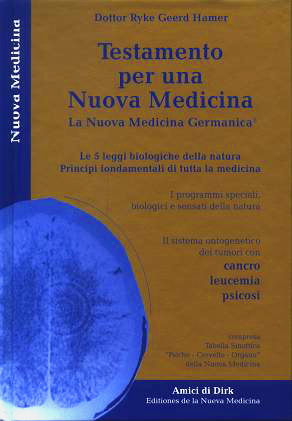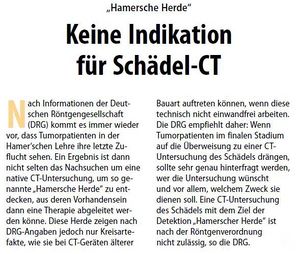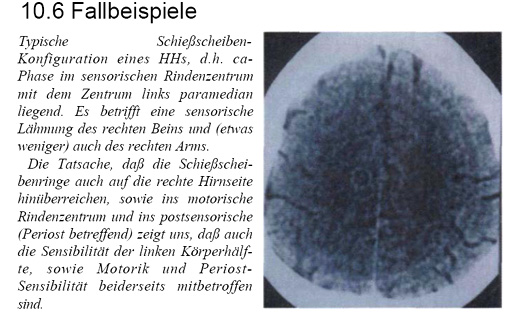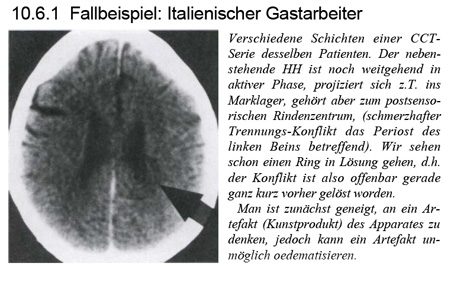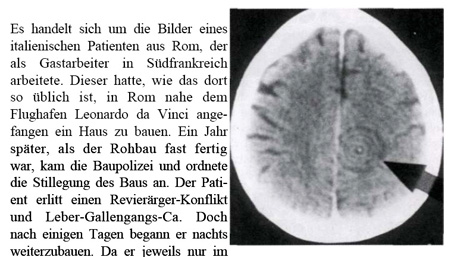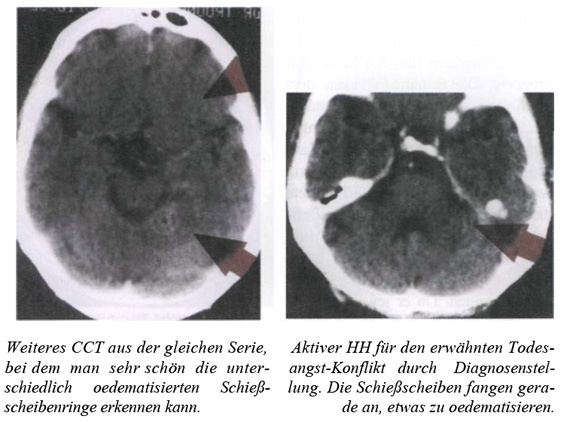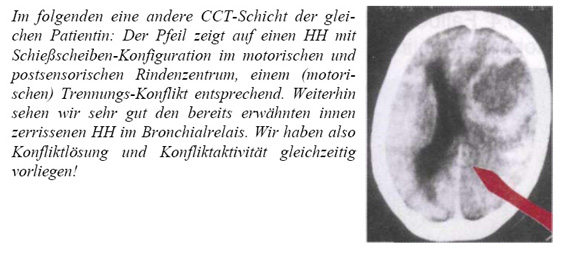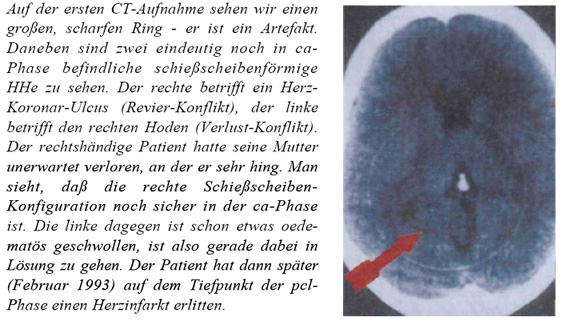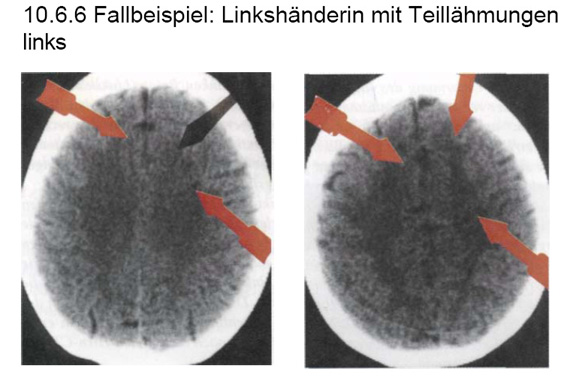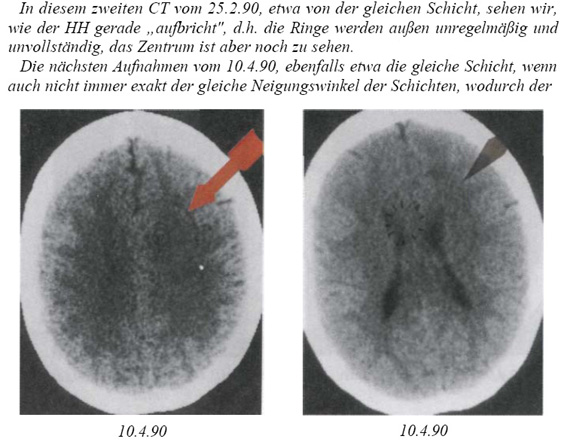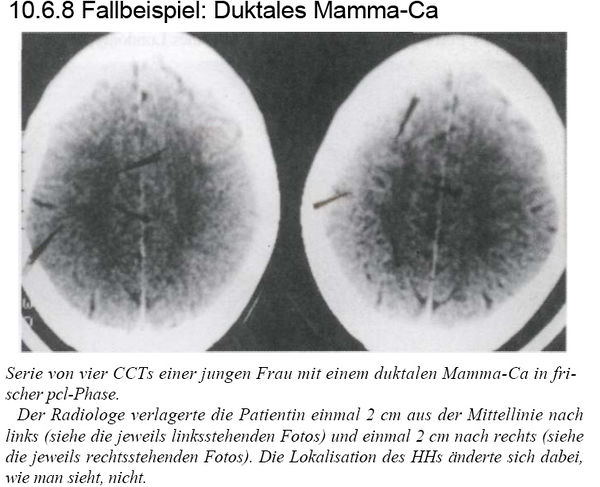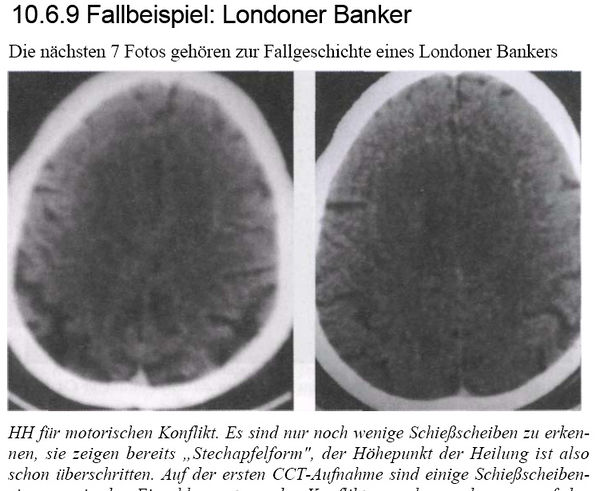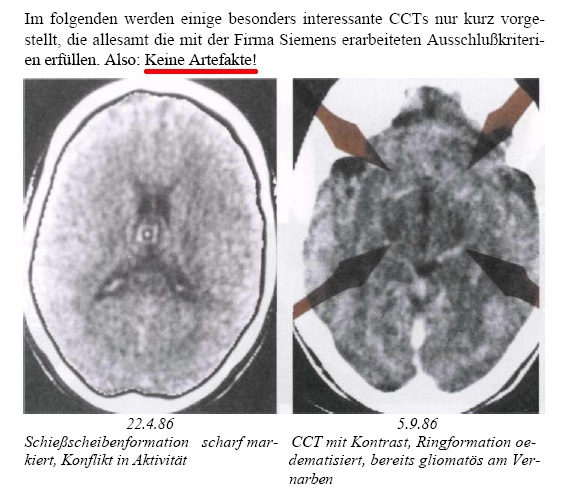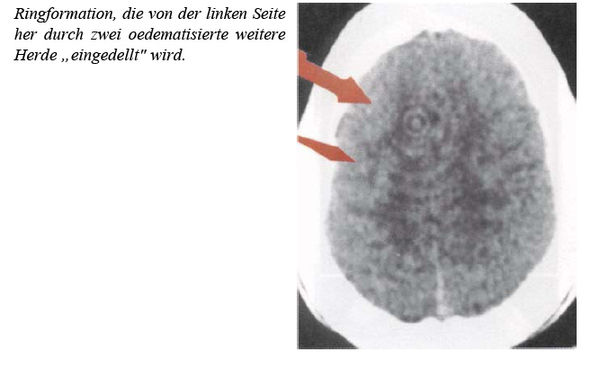Hamer-Focus
The former German physician Ryke Geerd Hamer and many followers of Germanic New Medicine count their diagnosis on a very particular interpretation of computer tomography brain scans of patients. This interpretation is not compatible with modern academic radiology. Hamer himself is not radiologist. In his books and on his web pages, he shows many brain scans but never mentions details about the type of scanner used, exact date, or high voltage and exposure time used. He never explains the radiological findings and the reason why the scans were made. For a better understanding: In radiology, usually the left side of brain is shown on the right side, because a physician usually faces the patient standings in front of them. So he looks from downside to upside. Hamer presents his scans mirrored: the left side is seen on the left side of the picture.
Hamer believes that a sudden shock-like onset of an unforeseen so-called biological conflict leads to a so-called "Dirk-Hamer-Syndrome" (DHS) which immediately (within a fraction of a second) produces a "cancer" in an organ. He postulates that every DHS-related process will take place synchronously in the brain, in the "organic brain" and in the organ. He adds that tumours forming were allegedly controlled by that part of the brain ontogenetically connected with the organ in question. Hamer calls this the "ontogenetic system of tumours". In the brain, the biological conflict is said to give rise to the development of a so-called "Hamer-focus". By this, Hamer means structures seen in CT brain scans which are shaped like a shooting target, or a single, mathematically precise circle. He claims the locations of these Hamer-foci and their degree of severity were correlated to the organs affected, the underlying biological conflict and the phase of the conflict. The non-radiologist Hamer adds that radiology was not able to detect these Hamer-foci until his inventions in 1981. According to New Medicine, the patient's right- or left-handedness was also significant.
The Ring Artefact (Ring Artifact)
Artefacts were quite frequent at the beginning of computer tomography, and a particular type of artefact, the ring artefact[1] was sometimes seen in early CT scanners, especially those of third generation, and are very seldom today due to progress in scanner technology. These artefacts are machinery-caused shapes superimposing the underlying scan. Usually they are easy to recognize and can be avoided by complying with the indications given by the manufacturer. Ring artefacts are always precise and perfect dark and bright concentric circles. Sometimes they may appear only as segments of a perfect ring and sometimes only one single circle may appear (if a specific single sensor is defective or not calibrated). The centre of the concentric circles corresponds with the axis of rotation of the scanner and sometimes may be seen outside of the subject or object in the scanner. These circles are caused by a defective sensor, a sensor with different sensibility than the other sensors, or after having forgotten to calibrate the entire scanner. An old fashioned CT-scanner had to be calibrated (with air or a water-phantom) at the beginning of service. After some hours a message told the operator to stop scanning and to perform a new calibration procedure as temperature influences and other effects were slowly modifying the performance of the individual sensors. These sensors must work at the limit of sensibility to avoid too large doses of radiation for the patient. Knowing this, an expert CT-operator may also be able to produce artificial rings-artefacts on purpose by avoiding calibration or by manipulating the device.
More about this issue:
- http://radiographics.rsnajnls.org/cgi/content/full/24/6/1679
- http://www5.informatik.uni-erlangen.de/Lehre/WS0506/MB-JASS06/slides/h-1-6.pdf
The famous Siemens certificate December 22, 1989
Hamer and his followers often name a certificate of a German CT-manufacturer, the Siemens company, dated December 22nd, 1989. They believe that this paper excluded the hypothesis that the Hamer-focus in fact was a technical artefact, namely a ring artefact. But the opposite is true. This document can be used to identify ring artefacts in many brain scans shown by Hamer. This documents does not deal with New Medicine or Hamer-foci.
It was Hamer himself to request this document (!) in 1989 that was written on December 22nd.[2] Hamer was one of the two persons signing the letter, the other was a Siemens engineer (not a radiologist). Hamer at that time had already been barred as a physician for three years and had to face the reproval by radiologists and other physicians to show artefacts. This document tells from the point of view of Siemens several conditions that are not compatible with ring artefacts.
Translation: Erlangen, 22.12.89. Possible ring artefacts. The undersigned [Hamer and engineer Feindor] have developed 8 [in fact only 7] excluding criteria regarding the presence of ring artefacts. Ring artefact do not appear if
- 1. in MRI (Magnetic resonance imaging or tomography) an analogue structure is visible [at the same location]
- 2. the circles are not perfectly circular, but show impressions, having a correlation with dislocation of tissue [irregular circles]
- 3. a formation corresponds to glial tissue [part of the brain, not being out of neurons. Glial tissue never shows up in circles however - see literature. Detection is only possible by analysing a tissue sample]
- 4. the centre or the circles do not correspond to the axis of rotation of the scanner ("parazentrale Schiessscheibenkonfiguration"="paracentral") [term used by Hamer]
- 5. further circles [therefore not being concentric] are seen, only one can be a ring artefact.
- 6. the circle structures have a clinical course [history], in other words: if they appear in the same location in future CT scans, but looking different.
- 7. scanner dependent artefacts are ring-shaped structures or ring segment shaped structures around the axis of rotation of the scanner. If these structures can be confused with biological structures, it is recommended to repeat the scan with a lateral or vertical dislocation of the patient. If the structure will not appear in a different location, in respect to known anatomical reference point, it is not an artefact.
Ing. Feindor, RG Hamer
This Siemens document does not mention New Medicine or Hamer and does not exclude the fact that Hamer shows ring artefacts in his books. The precise circular shape of many structures showed by Hamer correspond to item 2 in this document. There are no neuropathological reports that any of the Hamer-foci have ever been identified to be of glial-tissue according to item 3.
Expert opinion: Prof. Maximilian Reiser (University of Munich) in 2007
Professor professor Maximilian Reiser (University of Munich), president of German radiologists (Deutsche Röntgengesellschaft) was presented with some CT brain scans out of one of Hamer's books. Reiser wrote in an expert opinion on January 22, 2007:[3]
Expert opinion by Prof. Dr. med. Dr. h.c. Maximilian Reiser, director of the Institute of Radiology for Clinical Radiology of the Ludwig-Maximilian-University Munich, president of the Deutsche Röntgengesellschaft.
I willingly confirm that the brain scans presented in the "work" of Mr. Hamer have been interpreted in a completely inappropriate way by the author and are in clear conflict to scientifically justified knowledge and experience. An argumentative discussion of the content of Hamer's theories and the related interpretations of the brain scans in my opinion is neither possible nor yielding results because Mr. Hamer remains in a hermetically closed ambience of ideas and rejects any criticism as an expression of arrogant "orthodox medicine". I would like to confirm your corrections made in respect to some CT findings.
You may willingly quote this opinion as the opinion of the president of "Deutsche Röntgengesellschaft
Yours sincerely, M. Reiser
Other Opinions

The Swiss Study Group for Complementary and Alternative Methods in Cancer writes: [...] The «Hamer foci» on the CT images in Hamer׳s books have been identified by radiological experts as typical artefacts produced by the radiological device which can appear in a poor-quality CT scan [...][5] and the author Sören Ventegodt (Denmark) adds: [...] The concentric circles in the Hamer focus, shown on the front page of his book[1], looks like an artefact and very little as a biological phenomena, which in humans are almost never seen as concentric circles [...][6].
Warning letters to German radiologists
The Association of German Radiologists (Deutsche Röntgengesellschaft DRG) issued a warning letter to all its members. The radiologists were made aware that some people may try to undergo a CT-scan for further evaluation by GNM therapists, violating German RÖV regulations because of a lack of stringent indication. The same warning was also issued by another German Medical Association.[7][8][9]
CT brain scans presented by R. G. Hamer
The pictures are from his book: [10].
CT brain scans of a healthy subject fo comparison (not out of a Hamer book)
A modern scanner is used here, picture quality is far better.
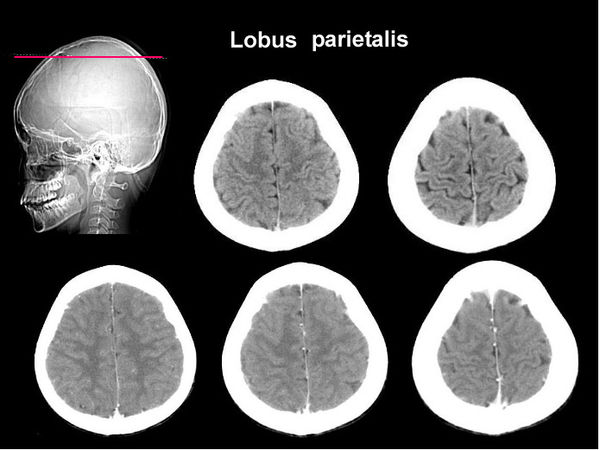 |
. |
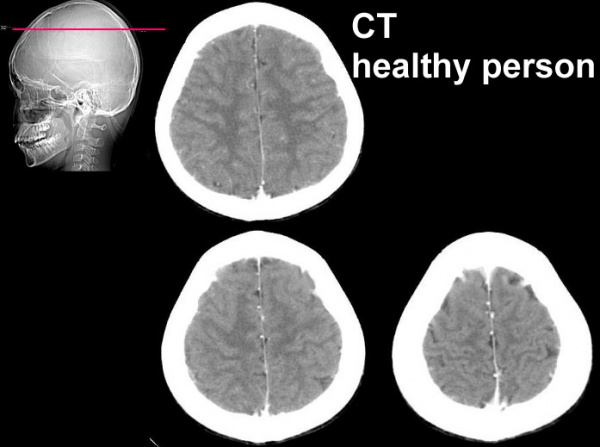 |
. |
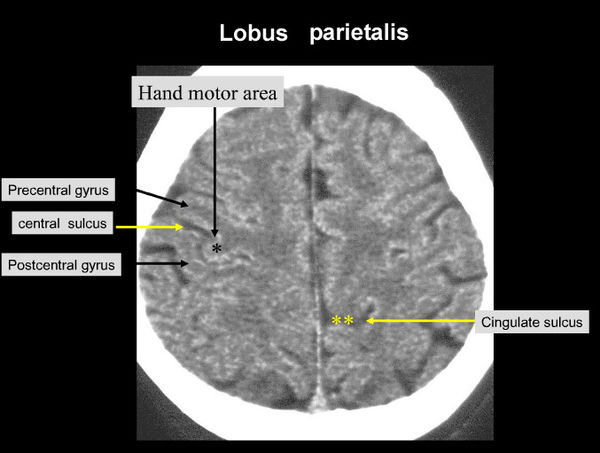 |
. |
Ring artefact example from a scientific study
Other CT brains scans of Hamer-foci in the internet
References
- ↑ http://www.medcyclopaedia.com/library/topics/volume_i/r/ring_artefact/gring_artefact_fig1.aspx?s=ring%20artefact&scope=&mode=1
- ↑ http://www.pilhar.com/Hamer/NeuMed/Zertif/891222.htm
- ↑ http://www.promed-ev.de/modules/news/article.php?storyid=105
- ↑ http://www.radpod.org/2008/03/24/ring-artefact-with-pseudomedical-interpretation/
- ↑ Swiss Study Group for Complementary and Alternative Methods in Cancer, SCAC. Hamer's «New Medicine» Document No. 01/02. [1]
- ↑ http://www.thescientificworldjournal.com/headeradmin/upload/2005.03.16.pdf
- ↑ http://www.kvsaarland.de/dante-cms/app_data/adam/repo/5975_CT_Untersuchungen_ohne_rechtfertigende_Indikation.pdf
- ↑ http://www.bezirksaerztekammer-trier.de/ak_aktuelles_det.php?lfd=280
- ↑ http://www.laekh.de/upload/Hess._Aerzteblatt/2009/2009_07/2009_07_05.pdf
- ↑ Hamer RG, Vermächtnis einer neuen Medizin, first part, editor. Amici Di Dirk

